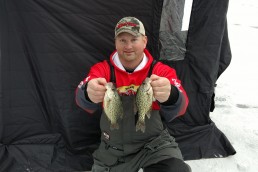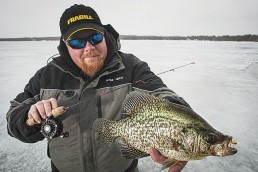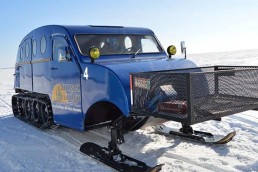Icing Gills, Perch and Slab Crappies
SHARE THIS POST
Ice fishing can be as simple or as complicated as one would make it. If simplicity and fun is in store, then follow the advice of these three anglers. Their advice has helped many anglers land more fish and made an impact with me.
Brian Brosdahl is perhaps one of the finest ice anglers in the country. He was gracious enough to assist me in becoming a better ice angler. Brian prefers hard-water panfish. The first thing Brian wanted to make clear is safety. Always carry a set of spikes around your neck. Not in your pocket, around your neck for quick use.
Second, carry a rope. A rope will make it easier in assisting others or yourself. Last, you could consider a Frabill I Float suit. Rated as a PF8 suit, it keeps your head afloat if you do take a spill.
His favorite location is a weedbed. Any type of weeds can harbor panfish. Cabbage is best. Milfoil, saw grass and other weeds will also hold fish. The key is a healthy weed. If the weeds are still green fish, use them. If they are floating and brown, vacate the area. He uses his underwater camera when searching for fish.
Spots to start
He marks all good-looking spots and locations where fish are caught. He also labels each spot for future use. He suggested looking for the largest flats on a topo map before heading out. Look at the depth where the first breakline starts.
Gills love the weeds but also use the edges of the break or drop-off. Often, they will suspend over the edge and can be as much as 10 feet off of the bottom. Perch, on the other hand, will cruise the bottom. Crappies will suspend over the break and many times away from the break by as much as 50 feet.
Picking the right bait
“Match the hatch when picking a bait or lure to use,” said Brosdahl. By this he means using smaller baits, lighter lines and a natural presentation. Experiment with Tungsten baits but remember that lead teardrops can be made in many shapes that tungsten is not made in.
He always fishes with a plastic on one rod or all his rods. The plastic can be added to a teardrop and tipped with live bait or fished without any meat. He loves lures made with UV. UV-coated lures give off more light in the water and are easier for the fish to locate. His favorites—the Impulse line from Northland Tackle.
Presentation pointers
“Fish slowly, keep your jigging action subtle,” said Brosdahl. Watch how plankton move in the water and duplicate that. Scented plastic baits are best. Always remember to keep the point of your hook covered. You will catch more bluegills with the hook point covered by the plastic or with a piece of meat.
Test the action of your lure in your hole where you can see it. The key to plastics is just enough movement so that the tail moves, nothing more.
Keep your bait at the fish’s eye level or above. They will rise up slowly and suck your bait in. Sometimes they will circle the bait and then glide in for the kill.
Save your slush
I leave the slush in my hole,” said Brosdahl. Some anglers call him a messy angler, but he truly believes that a clean hole lets way too much light in. He wants to fight the slush and force his bait down the hole.
Brosdahl drills a lot of holes until he sees fish or green weeds on his Aqua Vu. He uses an 18-volt cordless drill with a 4-inch bit. He changes over to a 6-inch bit if he needs it.
Chip’s tips
Chip Leer is an ice angler that truly understands fishing on the ice. He writes the email newsletter Fishing on the Wild Side which is free. “Early ice, I look for small bodies of water and then target any weeds,” said Chip Leer. One of his most important tips was research.
“Think of cutting a hole like making a cast,” said Leer. The difference is that you are severely limited in the number of holes that you can cut in a day. Chip spends as much time as possible studying topographic maps, talking with sport shops and other anglers. On the topo maps, anglers should look for large flats, humps and secluded flats that could have weeds far from the most popular locations.
Are you enjoying this post?
You can be among the first to get the latest info on where to go, what to use and how to use it!

All in what you ask
When he talks to other anglers and sport shops, he does not ask them where to fish. Instead, he will ask questions such as: where are the weedbeds located, is there more than one area with weeds? How deep do the weeds run? How deep is the main basin? Does this lake have any soft or mud-bottom areas? These types of questions get answered much more quickly than “tell me where the fish are biting.” He also relies on an underwater camera. A camera will show fish and how and where they are located in regards to an edge or type of bottom.
Rule of three
“When I fish, I use the following rule of three. One, attract the fish to your lure/bait. Two, tease the fish. Three, trigger the fish into biting,” said Leer. When he drops his bait down the hole, he will start with a 6 to 10-inch lift and a pause. Then a shorter lift with a pause.
Some days, a slight tap to the butt of the rod is all the action required. It really becomes a chess game. The angler paying close attention to the small details is the angler with the most fish.
In clear water, he likes baits with color and flash to draw them in from a distance. For dark water, he uses something with a rattle or a thump. He also mixes the type of lures used and material. Tungsten, lead and even zinc.
Smelling up the place
Chip loves plastics and scent plastics are his favorite. If your bait does not come scented, add a bit of scent to you lure or teardrop. Chip loves the UV colors and suggested using a UV flashlight to get the maximum light/glow and the longest time between charges.
Bill’s best bets
“Any green weedbeds are tremendous early season locations,” said Bill Ferris of Michigan. As a general rule of thumb, concentrate on depths 6 to 8 feet. Each lake is different, but this is a good guide.
If the weeds are brown, move along. Look for small pockets of healthy weeds. As the weeds die off, move to the first drop-off or the edge of where the weeds stopped growing. When you work the edges or drop-offs, search out the spot on the spot.
Many times, this will be a cup, an inside turn, a small point extending out from the shallow flat. Another good location is where the bottom changes from marl to mud, sand to mud, marl to gravel.
“Google maps and Navionics on my smart phone really help in locating small, isolated spots,” said Ferris. You can download Navionics at a cost of $10, if I remember correctly. Using both of these tools will assist in finding the edge, points and changes in the depth.
Hooking more ‘gills
“Bluegills normally are found in the bottom half of the water column while crappies are found in the upper water column,” said Ferris. Gills within 4 feet of the bottom, crappies can be within a foot of the surface—especially at last ice.
If the fish rise up and look at your bait and then move down, consider changing the color of your lure. Many times, changing the color of your teardrop or your plastic tails will entice a fish to bite more so than getting crazy with your jigging cadence.
“I use a lot of the Moon Glitter and Moon Jigs from Stopper Lure/K & E Tackle,” said Ferris. He tips the teardrops with a spike or with a plastic tail. Wigglers get the nod when perch fishing. He finds himself using the plastic more often than live bait. A tip he pointed out is in checking the position of the point of the hook. Make sure that the point is pointing slightly outward, not inward.
The size of his teardrops will surprise you. Chasing ‘gills, he uses a size 12 the most, some days even a 10. He only uses a 16 when the fishing is super tough. For crappies and perch, he steps up the size even further.
A spring bobber is used nearly always. Bill prefers the spring bobber with the pink tip from K & E Tackle. Favorite colors on his teardrops include fire tiger, natural perch, black/green and glow baits.
MWO
SHARE THIS POST
Did you enjoy this post?
You can be among the first to get the latest info on where to go, what to use and how to use it!
Jack Payne
Jack Payne is an accomplished angler and hunter who enjoys teaching others as much as learning from others. Seminar speaker, outdoor photography enthusiast, hunter safety instructor and volunteer at many events for both kids and adults as an instructor.



